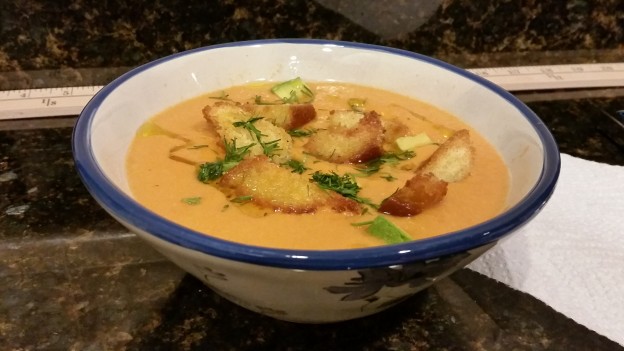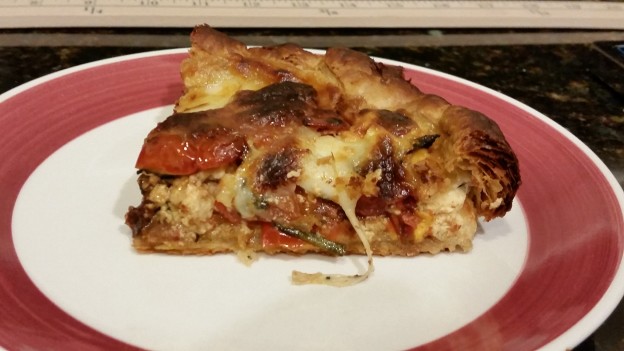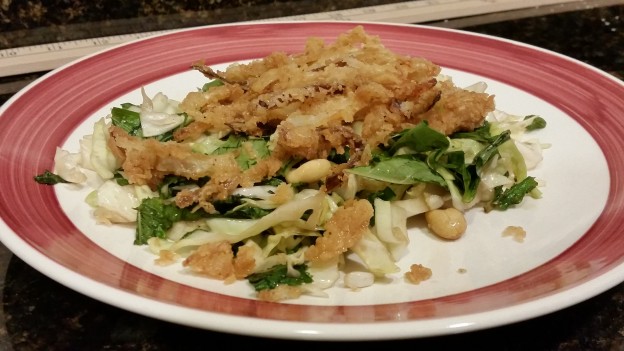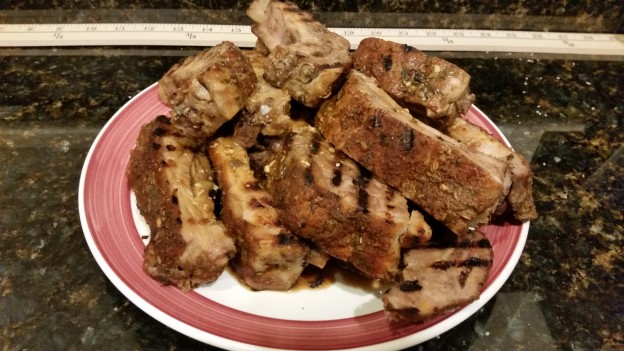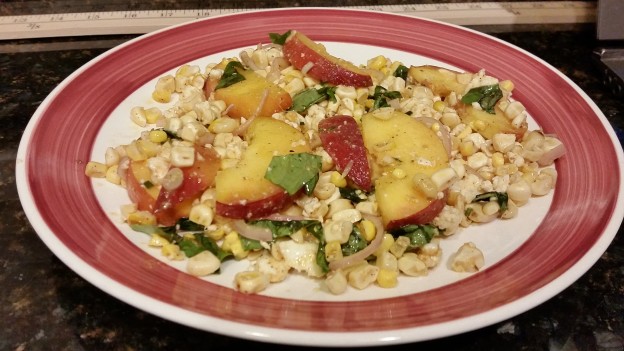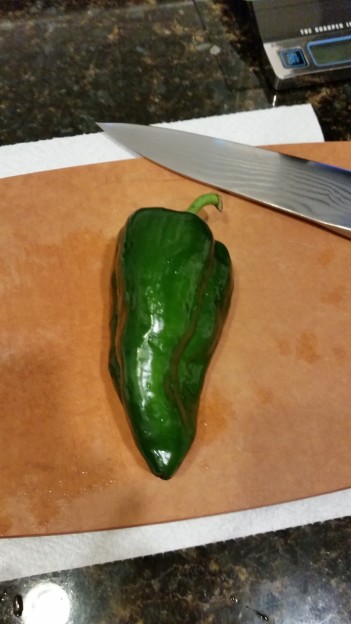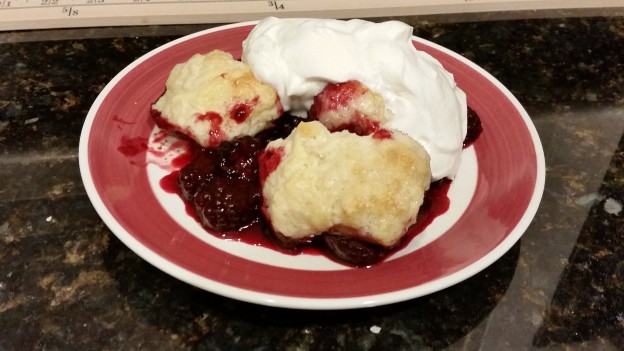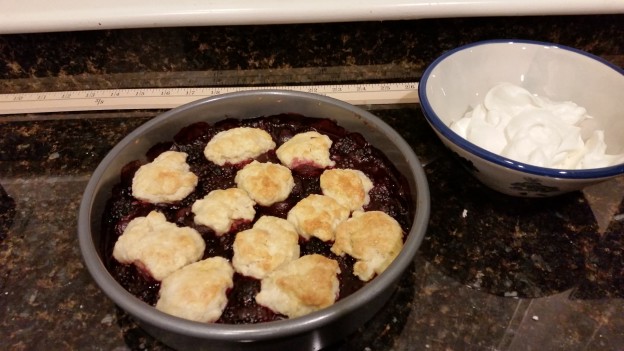For those of you who don’t remember, Watson is the AI who beat Jeopardy champion Ken Jennings in a game of Jeopardy.
Well, Watson is a chef now (among other things). So I decided to work on a few recipes from his book.
A few notes before we begin. Watson’s recipes are filtered through professional chefs at the Institution of Culinary Education. (Not to be confused with the Culinary Institute of America.) I have no idea how many failed recipes Watson spat out before the ICE hit on a few interesting publishable ones. Not only that, but some recipes are tweaked by the human chefs. (In a few cases, Watson just spat out an ingredient list, and the human chefs had to figure out the ratios and techniques.)
That said, what Watson did is still quite a feat. I’d say it’s more akin to the AI that made Magic cards. Sure, there’s a lot of garbage, but every now and then, it comes up with something interesting, that a human game developer could take and develop into an interesting Magic card. Likewise, even if Watson spits out some garbage recipes, it’ll also spit out some interesting ideas that real chefs can work with. (The real question, of course, is if Watson can do better than infinite monkeys.)
I decided to start with chapter 5 “Home Cooking With Watson”, because the recipes here were developed in collaboration with Bon Apetit magazine and were designed with home cooks in mind. This chapter had 3 appetizers (or more accurate, 1 “appetizer” and 2 “sides”), 3 entrees, and a dessert. So every week, I chose 1 appetizers and 1 entree (specifically, going through the appetizers and entrees in order), and then culminated in the dessert. Because dessert!
Appetizer: Spicy Tomato Gazpacho with Ginger
The gazpacho recipe uses a few traditional ingredients like tomatoes, cucumbers, and jalapenos (I think those are in traditional gazpacho recipes), swaps out onions in favor of leeks (sauteed, of course), omits garlic altogether, and includes the totally non-traditional ginger. The recipe originally called for beefsteak tomatoes and cherry tomatoes, but I couldn’t find beefsteaks at the supermarket, so I swapped those out for romas. (Because romas.) Cherry tomatoes stayed in. The gazpacho is blended, then garnished with chopped avocados, fresh dill, and homemade croutons.
The flavor of the gazpacho was a little lacking. I mean, sure, I added plenty of salt until the gazpacho’s flavor shined through, but it was still a little traditional. I’m thinking either ramp up the ginger to add a little more distinct flavor, or ramp up the jalapeno to give the gazpacho a little kick.
The homemade croutons though. Apparently, it’s super easy to make homemade croutons, and they’re so much better than the stuff you find at grocery stores and even some restaurants. Basically, take some bread, chop or tear it apart, season liberally with olive oil, salt, and pepper, then bake for about 8 minutes. The more you season it, the more amazing they taste.
I also learned I hate dill. I mean, I always knew I disliked dill, but I never knew how much it takes over your fridge until I got some. And this was after it was double-bagged in a ziploc bag.
Entree: Roasted Tomato and Mozzarella Tart
I’m sure tomato tart is a real thing. Watson’s book describes it as “pizza’s fancy cousin who spent a semester abroad in Paris”. I described it as a cross between pizza and quiche.
The recipe called for puff pastry. I’ve never used puff pastry before. Usually, I just make my own pie crust or croissants from scratch. But I decided the point was to try Watson’s flavors, not to practice my puff pastry skills. So I bought some store-bought frozen puff pastry. And I discovered one thin sheet of puff pastry will inflate to over an inch thick if you don’t weigh it down properly. Kinda crazy.
I also halved the recipe, but I made one terrible mistake: I forgot to reduce the baking times. That’s fine, the tart was a little over-baked, but it didn’t burn or anything. But that’s a lesson for the rest of you: If you halve a recipe, reduce the baking time by, I dunno, 25%? Either that or my oven is just super efficient.
Overall, the tart has too much tomato and too much cheese and not enough egg custard. (But maybe that’s because I want it to be more quiche-like.) I mean, in the pictures in the book, you see distinct globs of melted cheese, but mine is just an entire top layer of melted cheese. And while it tasted of tomatoes, I really feel like this recipe needs some thyme. (Unless Watson’s whole point was not to use thyme and tomatoes, because the combination is kinda cliche.) Also, the book says Watson originally had smoked paprika in the tart, but the editors took it out because they thought it would be too over-powering. I say put the paprika back in.
Lastly, the recipe called for plum tomatoes and cherry tomatoes, but I couldn’t find plum tomatoes, so I just used romas. (Because romas.)
Side: Tamarind Cabbage Slaw with Crispy Onions
From a cooking technique perspective, the interesting thing here is frying the crispy onions. I actually took Alton Brown’s technique for fried chicken and applied it to the onions here, namely seasoning the onions directly instead of mixing the seasoning with the flour. The onions had good crisp and good flavors, but I think more salt and pepper would make them even better.
As for the slaw itself, cabbage, green onions, basil, mint, and roasted peanuts, topped with a sauce made from rice vinegar, olive oil, honey, tamarind, and (get this) fish sauce. The flavors came together pretty well, especially the mint and the basil. If anything, I should have prepared the slaw mix ahead of time and let it sit and let the flavors mingle.
Bonus: The fish sauce brand my cooking teachers is a brand they lovingly call “ugly baby fish sauce” (aka Golden Boy Fish Sauce). The simple act of opening the bottle has confounded amateur chefs for years.
Entree: Fennel-Spiced Ribs with Tangy Apple-Mustard Barbecue Sauce
The flavors here are pretty good. I don’t normally like fennel, but I think the spice rub actually worked on these ribs. The sauce had some good flavors to it too, but the recipe calls for adding the meat drippings to the sauce, and there’s very little sauce, so the texture comes out weird. It would be better if we made more sauce (there’s enough meat drippings to go around), made it on the stovetop, and turned it into some kind of gravy instead of a glorified fatty au jus.
The technique for cooking the ribs though didn’t work. (Either that or I botched it.) The book recommends wrapping the ribs in foil and roasting at 350 F for about 2 hours. My gut tells me low and slow would work much better, maybe even closer to a braise. Not that it matters. The whole point of the recipe was the flavors, and I think the spice rub and sauce got that part down. I’ll learn how to cook ribs on my own.
Side: Grilled Corn and Peach Salad with Toasted Spiced Vinaigrette
The recipe original calls for nectarines, but mentions peaches as a viable substitute. Since I have no idea what a nectarine is (seriously, my knowledge of uncommon fruits is quite lacking), I opted for peaches instead. Unfortunately, I haven’t developed that skill for telling how ripe a peach is, so I think my peach was a little under-ripe. Lesson learned, get the peach that is slightly mushy (but not too mushy). It’s kinda like picking out an avocado.
Besides the corn and nectarines/peaches, the recipe also calls for shallots, basil, and either panela cheese or cotija cheese (both are Mexican cheeses). Unfortunately, I didn’t realize that basil wilts quickly in the fridge (and this was double-bagged in a sealed ziploc bag), so I couldn’t get enough basil. The flavors were good. I don’t normally like raw onions, but this recipe made it work. but I bet they would have been better with more basil.
As a final note, the recipe calls for tossing the salad. I bet this recipe would work just as well as a composed salad.
Entree: Scallops with Tomato Relish and Green Tomato Consomme
Yes, this is the same photo as the header.
The book calls this the most challenging recipe in the home cooking chapter, and rightfully so. Except the hard part isn’t the scallops. If you know what you’re doing, scallops are easy to cook. No, it was the rest of the dish that threw me off.
First of all, that “green tomato consomme”. Wikipedia describes a consomme as “clear soup made from richly flavored stock or bouillon”. That’s not really something I want to serve with my scallops. And the process the book gives for making it (puree vegetables, freeze puree, let frozen puree melt in a strainer and strain out the liquid) throws away a lot of cromulent vegetable matter.
Also, I have no concept of what a “green tomato” is. The recipe lists it separately from tomatillos. Wikipedia implies that they are unripe tomatoes. I can’t find them in supermarkets anyway. So I just used tomatillos, because I know what those are, and they are green. So really, I made a tomatillo puree instead of a green tomato consomme. (Other than the fact that, you know, it didn’t melt in time for me to add to my final scallop dish.)
Finally, the tomatillo puree called for a few peppers, specifically a poblano (more on that later), a jalapeno, and a habanero. And the puree was super spicy. Maybe I should skip the habanero and let the puree stand on its own flavors. (Also, with or without the habanero, this would prolly make a good salsa.)
Other than that, the scallops came out pretty amazing. The tomato salsa is a little excessive (I don’t usually like tomatoes), but it does make for a pretty plate. Might be better with the tomatillo puree. The cilantro oil (that is, olive oil steeped with cilantro) and the smoked Maldon salt pushed the flavor of the scallops over the edge.
Bonus: Safeway doesn’t know the difference between a poblano and a pasilla (the stand was labelled “poblano/pasilla”), even though they’re clearly different peppers. Unfortunately, I can’t identify or distinguish them on sight. Hopefully one of you can.
Dessert: Blackberry-Cherry Cobbler with Honey Whipped Cream
I don’t know the technical definition of cobbler, but the book suggests that it’s pie filling with crumbled biscuits on top. So basically, pie easy mode. (Not to be confused with pie a la mode.)
The book itself calls out that this recipe seems straightforward, but that Watson had perfectly balanced all the flavors and added the secret ingredient: marjoram. The flavors itself were pretty good. The tartness of the blackberries came through, and the syrup was sweet and thick. (Could have used more marjoram though.)
The real winner were those biscuits though. I know people say biscuits are hard, but after making my own croissants and my own pie crust, biscuits are super easy. And this biscuit recipe was actually amazingly spot on. For reference, I made a half recipe, I added the buttermilk in 3 parts, folding 6 times each, and then I kneaded the dough about 12 times. It prolly helped that I banked the biscuits while sitting on top of the cobbler filling. (The biscuits sat on top of the cobbler filling, not me.)
Lastly, that whipped cream is actually half heavy cream and half sour cream. The sour cream adds a little something to the whipped cream and really complements the tartness of the blackberries.
Conclusion
So what’s the verdict? The book has some clear winners (gazpacho, scallops, cobbler) and some less-than-winners (ribs). Chef Watson does nothing innovative here, but it does do some interesting things. Really, it’s no different than any other cookbook, except with the gimmick of having been developed by an AI.
If you’re looking for a new cooking project, you might as well give Watson a try, just for curiosity’s sake. At the very least, it’ll be a fun experiment, and the food will be pretty decent. Don’t expect anything game-changing though.

